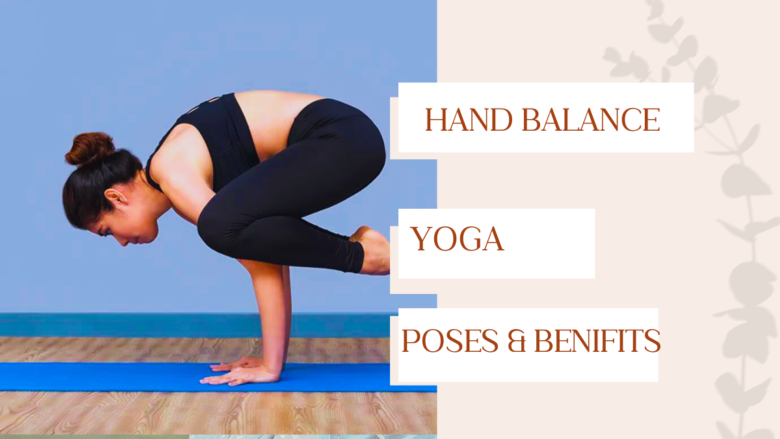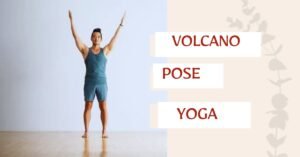Hand balance yoga poses are not just an impressive feat of strength and flexibility; they’re a profound practice that merges the physical with the mental, creating a bridge between the body and the mind.
🧘♀️🤸♂️ This comprehensive guide from Aatm Yogashala is designed to take you through the intricacies of hand balance yoga, from its rich history to the practical steps beginner yogis can take to start their practice.
Whether you’re a seasoned yoga enthusiast or just starting, this guide aims to enrich your understanding and inspire your practice. 🌟📚
What is hand balance yoga
Hand balance yoga, often referred to as “arm balances,” encompasses a variety of yoga poses where the practitioner balances on their hands while aligning their body in different postures.
This practice goes beyond mere physical exercise, challenging individuals to cultivate strength, focus, and a deep internal awareness. Hand balance poses range from the fundamental Crow Pose (Bakasana) to more advanced positions like the Crane (Crane Pose) or Handstand (Adho Mukha Vrksasana).
These asanas not only enhance muscular strength and endurance but also improve balance, concentration, and the mind-body connection, offering a holistic approach to personal fitness and mindfulness.
Benefits of Hand Balance Yoga
Hand balance yoga offers numerous benefits, positively impacting both the mind and body. It enhances core strength and stability, crucial for maintaining balance and augmenting posture, which is beneficial in alleviating back pain caused by prolonged sitting.
Practicing hand balance yoga also improves mental clarity and focus. The concentration needed for mastering hand balance yoga poses soothes the mind, reduces stress, and promotes mindfulness.
This discipline fosters a sense of accomplishment and confidence as individuals progress, overcoming obstacles and succeeding in poses that once seemed insurmountable.
Additionally, hand balance yoga advances proprioception, or the awareness of the body’s position in space, aiding in better coordination and preventing injuries.
list of Hand Balance Yoga poses
- Crow Pose (Bakasana)
- Crane Pose (Crane Pose)
- Side Crow Pose (Parsva Bakasana)
- Eight Angle Pose (Astavakrasana)
- Handstand (Adho Mukha Vrksasana)
- Firefly Pose (Tittibhasana)
- Peacock Pose (Mayurasana)
- One-Legged King Pigeon Pose
- Lotus Headstand
- One-Legged Crane Pose
1. Crow Pose (Bakasana)
Steps:
- Start in a squat position, keeping your hands flat on the floor shoulder-width apart.
- Place your knees on the back of your upper arms.
- Lean forward, transferring your weight onto your hands, and carefully lift your feet off the ground.
- Keep your gaze forward and hold the posture.
Benefits:
- Strengthens the wrists, forearms, and abdomen.
- Improves balance and focus.
2. Crane Pose (Crane Pose)
Steps:
- Begin in the same squat position as Bakasana, with your hands on the floor.
- Straighten your arms, unlike in Bakasana where they remain bent.
- Lean forward to shift the weight onto your hands, lifting your feet up off the ground, one at a time if necessary.
- Keep your gaze forward, balancing on your hands with your arms straight.
Benefits:
- Enhances arm and core strength more intensively than Bakasana due to the requirement of straight arms.
- Improves balance and concentration.
3. Side Crow Pose (Parsva Bakasana)
Steps:
- Begin in a squat position with your hands together in a prayer position at the center of your chest.
- Twist your torso to the right, placing your left elbow on the outside of your right knee.
- Plant your hands on the floor beside you, shoulder-width apart.
- Lean forward, transferring your weight onto your arms, and lift both feet off the ground, keeping them together.
- Hold the position, keeping your gaze forward.
Benefits:
- Strengthens the arms, shoulders, and obliques.
- Improves digestion through the twisting action.
- Enhances balance and focus.
4. Eight Angle Pose (Astavakrasana) Best Hand Balance Yoga
Steps:
- Start in a seated position with your legs extended forward.
- Bring your right knee to your chest, then place your right foot over your left arm and hook it behind your right shoulder.
- Plant your hands beside your hips on the floor and lean forward slightly.
- Lift your buttocks and left leg off the floor, then extend your left leg under your right leg, crossing your ankles if possible.
- Extend your legs to the right side, using your arms to balance and lift your body off the ground.
- Hold the posture, gazing forward.
Benefits:
- Greatly increases arm, wrist, and shoulder strength.
- Enhances core strength and stability.
- Improves balance, focus, and coordination.
5. Handstand (Adho Mukha Vrksasana)
Steps:
- Begin in a downward-facing dog pose.
- Walk your feet towards your hands, bringing them as close to your hands as you can.
- Slowly lift one leg off the ground, keeping it straight and strong, then lift the other leg up to join it.
- Keep your arms straight and strong, with your gaze between your hands.
- Hold the pose for a few breaths, then come back down to the starting position.
Benefits:
- Increases upper body strength, particularly in the shoulders and arms.
- Enhances core strength and stability.
- Improves balance and focus.
Also Read:
6. Firefly Pose (Tittibhasana)
Steps:
- Begin in a squat position with your feet shoulder-width apart.
- Place both hands on the floor behind and between your legs.
- Lean forward, shifting your weight onto your arms, and lift your feet off the ground, extending them straight out to the sides.
- Hold the posture, gazing forward.
Benefits:
- Strengthens the arms, wrists, and core.
- Improves balance and coordination.
- Tones the abdominal muscles.
7. Peacock Pose (Mayurasana)
Steps:
- Begin in a kneeling position with your hands on the floor shoulder-width apart.
- Bend your elbows and place them on the back of your thighs, just above the knees.
- Lean forward onto your elbows and lift your feet off the floor, extending them straight behind you.
- Keep your arms bent and strong, holding the posture for a few breaths.
Benefits:
- Strengthens the arms, wrists, and core.
- Stretches and tones the spine and abdominal muscles.
- Improves balance, focus, and coordination.
8. One-Legged King Pigeon Pose (Eka Pada Rajakapotasana)
Steps:
- Start in a downward-facing dog pose.
- Bring your right knee forward and place it on the floor between your hands.
- Extend your left leg straight behind you.
- Lower your body onto your forearms, keeping them shoulder-width apart and parallel to each other.
- Hold the posture for a few breaths, then repeat on the other side.
Benefits:
- Stretches and tones the hips, quadriceps, and gluteal muscles.
- Improves balance and core stability.
- Enhances spine flexibility and posture.
9. Lotus Headstand (Padma Sirsasana)
Steps:
- Begin in a kneeling position, with your hands on the floor shoulder-width apart.
- Place one foot behind your head, resting it on your neck.
- Lean forward onto your forearms and lift your legs off the ground, extending them straight up towards the ceiling.
- Hold the pose for a few breaths before carefully coming back down to the starting position.
Benefits:
- Increases upper body and core strength.
- Enhances balance, focus, and concentration.
- Improves spine flexibility and posture.
10. One-Legged Crane Pose (Eka Pada Bakasana)
Steps:
- Begin in a squat position with your hands on the floor.
- Straighten your arms and lean forward, placing your left knee on the back of your left upper arm.
- Lift your right foot off the ground and extend it straight behind you.
- Keep your gaze forward and hold the posture for a few breaths before repeating on the other side.
Benefits:
- Strengthens the arms, shoulders, and core.
- Improves balance and coordination.
- Enhances focus and concentration.
Common Mistakes to Avoid
- Rushing the Process: Don’t expect to master these poses overnight. Patience is key.
- Neglecting Core Engagement: Active abs are crucial for stability in hand balance poses.
- Ignoring Breath Control: Breath control can significantly impact your ability to hold a pose.
Conclusion for hand balance yoga poses
Hand balance yoga poses offer a unique blend of physical and mental benefits, making them a highly fulfilling practice for those seeking to challenge themselves both physically and mentally. From the fundamental Crow Pose to more advanced handstands, hand balance yoga poses not only improve strength and stability but also enhance focus, body awareness, and self-confidence.
While they may seem daunting at first, with practice, hand balance yoga poses serve as a foundation for developing strength, balance, and mental clarity in your hand balance yoga practice. Each hand balance yoga pose not only offers its own set of physical benefits but also challenges and hones your focus and determination, reflecting the practice’s holistic approach to wellbeing.
Faqs for hand balance yoga poses
1. How often should I practice hand balance yoga poses?
Practicing hand balance yoga poses can vary depending on your level of experience and physical condition, but a good starting point is 2-3 times per week. This allows your body to rest and recover between sessions of hand balance yoga poses.
2. What should I do if I keep falling out of the pose when practicing hand balance yoga poses?
Falling is part of the learning process when practicing hand balance yoga poses. Focus on building strength and balance gradually. Use props such as yoga blocks and straps to assist you in your hand balance yoga poses, and don’t rush the process.
3. Can hand balance yoga poses help reduce stress?
Yes, hand balance yoga poses require concentration and focus, which can help distract from daily stressors and promote a sense of mental clarity and calm. Practicing hand balance yoga poses is an effective way to manage stress.
4. Are there any precautions I should take before starting hand balance yoga poses?
If you have any pre-existing conditions, especially wrist, shoulder, or back issues, consult with a healthcare provider or a qualified yoga instructor to modify hand balance yoga poses as necessary.
5. How can I measure my progress in hand balance yoga poses?
Progress in hand balance yoga poses can be measured in various ways, including increased hold time in poses, improvement in form, and the ability to perform more advanced variations of hand balance yoga poses. It’s also important to acknowledge non-physical progress, such as enhanced focus and mental resilience.



